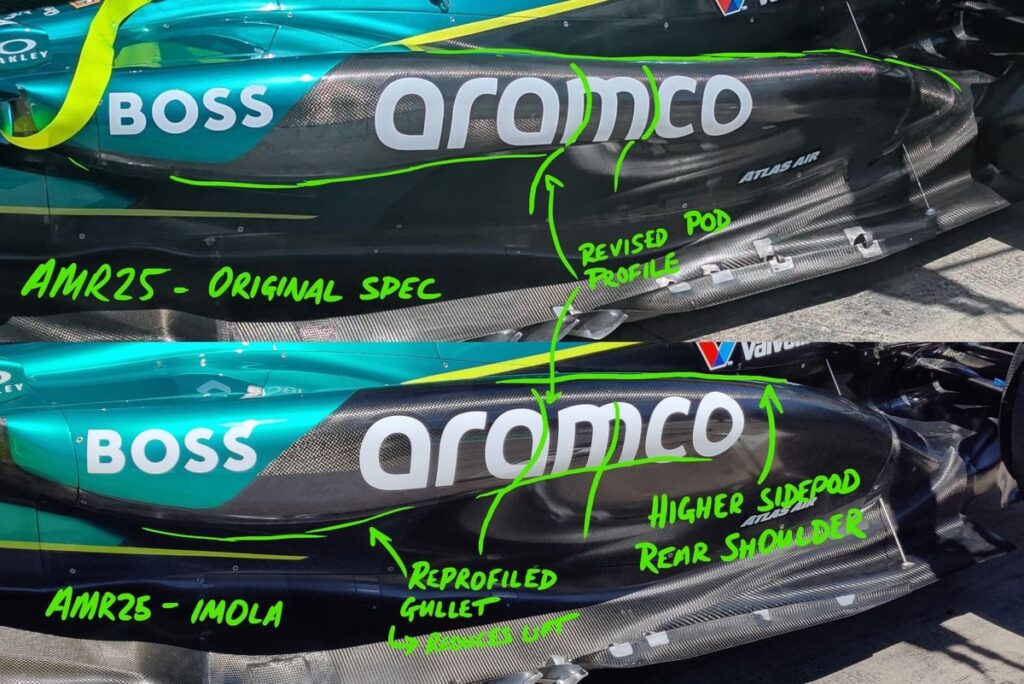There are a few conditions to be aware of when it comes to the latest iteration of the AMR25. It was not wholly conceived in the British squad’s brand new wind tunnel; most of the development work with the package took place in December and January in Mercedes’ wind tunnel, with the final validation work being moved across to Aston Martin’s Silverstone towers before the package was produced.
And if that sounds like a long gestation process, it suggests that the team was well aware of the AMR25’s shortcomings at the point at which the design was ‘frozen’ – when the car is snapshotted in a given spec for the build, and subsequent developments are packaged up later and put into the pipeline.
Seven distinct areas have been noted by the team in its pre-event technical notes, although four of these pertain to the underbody; the main floor “body” (the tunnels and central section) has been reshaped, the floor fences (the vertical strakes) are of a slightly different curvature to assist with airflow direction and conditioning, the edge wing has received detail changes, and the diffuser “shoulder” has also been reprofiled.
But there’s more; the halo mounts have taken delivery of a new, smaller fin, while the engine cover’s ‘Coke bottle’ has been tightened up to help improve floor performance. There’s also a new beam wing.
Here’s how the team has looked at the Coke bottle profile, firstly with its reshaping of the sidepods. The rear shoulder of the sidepod has been moved slightly higher up, which protects the channel along the top of the sidepod geometry. As such, the airflow directed towards this is less likely to bleed out of the channel.
As the air passes over the top of the sidepods into the Coke bottle section, it can pull the airflow moving around the sidepods with it to ensure there’s a little more energy within the flow. As such, it’s able to stay attached to the top part of the floor – thus ensuring that the diffuser suction is improved.
The floor edge changes appear to be tiny, but there are a few key modifications here if you get your magnifying glass out. Firstly, the transitions along the top surface appear to be smoother towards the front, while the edge wing appears to have received minor dimensional changes to its chord and camber.
As for the cluster of flick-ups in the centre, these have been addressed too – the front two have been made slightly larger, with the final flick-up now shorter in chord length and given an S-shaped treatment to the profile.
Lance Stroll began with the package on Friday, with the team to make an executive decision to run with it on both cars following its digestion of the data overnight.
“It’s a bit tight [on parts], but we’ll try,” said deputy technical director Eric Blandin. “Hopefully the cars will stay on the track and, first of all, let’s hope that the package works. It should be a good step, so let’s see how it goes. And secondly, if it goes well, hopefully we can put both cars on it tomorrow.
Blandin reckons that the team’s lapse in form over 2024 and the start of 2025, following its excellent start to 2023, has given it something of a wake-up call to revise its development process.
With substantial work being undertaken at Aston Martin’s plush new headquarters on the 2026 car, the team has tried to get its ducks in a row with developing the 2025 package to help improve its procedures for the new regs.
“One thing we have learned through the last couple of seasons is that actually we need to get better with our processes. We did a decent car in ’23, and that probably derailed progress a little bit in the sense that we have not reviewed all the processes as we should have done.
“Now is the time to actually consolidate and improve the organisation, the processes, in order to make a big impact in ’26.
“We hope first to gain a few tenths compared to our competitors, and get back in the fight. Ultimately, the last two races have not been great for us, so we just need to get more competitive.”
On pace, Aston Martin has somewhere between the eighth and ninth fastest car, depending on the circuit and the session. Haas is less consistent in qualifying, but the American team has proven more capable of reaching Q3 when circumstances allow. Fernando Alonso, meanwhile, has qualified 13th on four occasions this year and is yet to break into Q3 of grand prix qualifying.
A year ago, Aston Martin’s Imola updates rather set the path to its current regression – now, at the same circuit east of Bologna, the green machines are hoping to successfully bounce back.
In this article
Jake Boxall-Legge
Formula 1
Be the first to know and subscribe for real-time news email updates on these topics
Subscribe to news alerts
Read the full article here

